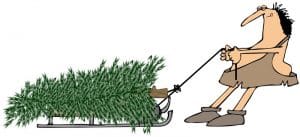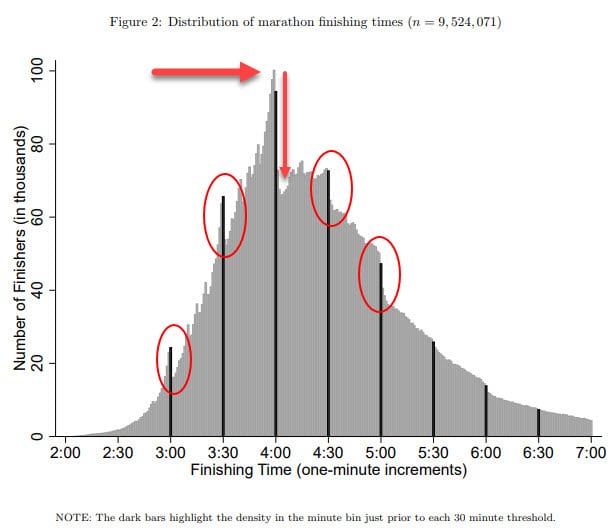Imagine you are a caveman, and you are 
working really hard dragging a sled of
supplies uphill to your cave. You look over at your neighbor and he too is working to get supplies uphill to his cave.
… but he has wheels on his cart.
Sometimes, there is an easier way to accomplish your goals. The surprising news from research is that due to a quirk in human perception, you can “put wheels” on your efforts to make real progress toward your goals.
Using the technique I am about to share with you, one person said, “I found it surprising that I could do [what I struggled to do previously, but this time] without a tremendous amount of effort or commitment.”
In their fascinating book, The Power of Moments: Why Certain Experiences Have Extraordinary Impact, Chip and Dan Health show us (among many other things) how we can alter and then leverage our experiences to see greater progress toward our goals.
Accomplishing Your Goals An Easier Way – One Example
Although there are many fascinating principles revealed in The Power of Moments book (it’s worth the time to read!), I want to zero in on a single approach that can transform how you approach a desired goal.
Just ask Josh Clark. In 1995 at the age of 25, Clark desired to get into better shape… so he started jogging.
But, there was a problem. He hated jogging.
As a result, because of the boredom and pain experienced, he would quit for a while, only to restart with great resolve… then hate the whole experience all over again.
Yet, over time, he stumbled upon an approach that allowed him to get to “the other side” where he not only didn’t quit… and actually started enjoying jogging.
He was so excited about what he learned that he talked his skeptical mother into trying his approach. Although her early reaction to the idea was negative, she gave it a shot.
Shockingly, it worked for her, too. As she reported, “I found it surprising that I could do it without a tremendous amount of effort or commitment.”
Wow… those words are music to my ears 😊
Josh launched his approach (Couch to 5K) that has now enabled tens of thousands of people to prepare for a 5k run in 9 short weeks… even if you had never run before.
How was Josh, and so many others able to see success in their efforts when previous efforts could not?
They were able to leverage a quirk in how we are wired.
How People Really Perceive Time & Events
Researchers discovered an oddity in how you and I perceive events… and how they impact us.
Called the Peak-End Rule, it recognizes that not all moments are equal. Instead, there is more potency in certain “peak” experiences, as well as what we experience toward the “end” of a series of events.
These peak and end experiences then color and influence our perception and recollection of ALL our experiences immediately before and after them.
To learn about 50 human perception biases we can’t 
see, yet influence and impact virtually every aspect of
life, download the free infographic, 50 Hidden Influences
Impacting Your Decisions (and how you perceive reality)
For example, you could go on a 7 day vacation and have an ok time overall (the average of all your experiences). But oddly, you would find yourself concluding the vacation was great because of one experience on day 3 and/or one highly enjoyable experience on the last day.
Just a handful of peak experiences and/or how the event sequence ends up have more impact and influence on you than all the other experiences… combined.
I know it doesn’t seem right, but that’s how our brains process and assess events.
Here’s the question: How can you leverage the disproportionate power of the peak-end rule to help you more effectively reach your goals?
Using the Power of Peaks in Accomplishing Your Goals
One dimension of your “event perception” that you can use to increase your ability to accomplish a goal: shaping and amplifying your peak experiences.
Let’s face it, most goals have little intrinsic motivation built into their approach. Often, we take the “just do it!” willpower approach.
For example, let’s say you want to learn a foreign language. You decide: I will learn Spanish by the end of the year! You might even add steps:
- I will review vocabulary cards 3 times a week!
- Once a week I will watch a lesson online.
Yawn. No wonder you lose interest and motivation to keep going. Good intentions only go so far.
This typical approach is like being football players who experience grueling practices multiple days every week… but who never actually get to play a game (experiencing the exciting peak reward for all your hard work during the week).
How motivated would you be to keep practicing… without the peak experience of playing a game?
Beefing Up the Peaks (Leveling Up)
Instead of the boring, willpower driven approach to making progress toward your goals, you can inject peaks using the power of “leveling up.”
Leveling up comes from the world of video games, where you feel so good when you get to the next level.
You’ve experienced this: you get a feeling of accomplishment (which boosts motivational energy to keep going), plus reaching the next level allows for a mini-celebration (giving you even more motivational juice).
Combine this leveling up approach with making each level more interesting and you will experience greater motivation to keep going.
For example, in the Power of Moments book, they suggest the following levels to spice up learning Spanish:
Level 1: Order a meal in Spanish
Level 2: Have a simple conversation in Spanish with a taxi driver.
Level 3: Glance at a Spanish newspaper and understand at least one headline
Level 4: Follow the action in a Spanish cartoon.
Level 5: Read a kindergarten-level book in Spanish.
Ultimate Level Z Destination: Be able to have full, normal conversations in Spanish with Fernando in accounting.
Notice how each level doesn’t necessarily seem unreasonable and is more interesting than just doing a lesson by itself.
Perhaps more importantly, after each level you experience the peak sense of accomplishment that energizes you, propelling you forward toward the next goal.
By setting a celebratory reward for the attainment of each level (e.g. try a new Mexican beer, or visit a Mexican restaurant), you have even more motivation to keep going.
There is yet another impactful dimension you can incorporate into your goal attainment.
The Power of “End” Milestones in Accomplishing Your Goals.
There is something crazy about how we are wired that compels us to give a little extra toward a finish line to complete something.
If you don’t believe me, go no further than the irrational behavior of owners of Fitbit devices and other health monitoring apps. I know people in my family who will keep walking around the house in the evening because they are close to reaching their step goal.
Or consider this fascinating graph. It shows the
finishing times of over 9 million marathon runners. 
Notice the dramatic drop off of finishers after every 30 minute increment (especially noticeable at the 4 hour mark).
It shows the large number of runners who give it a little extra as they get close to finishing at the 30 minute mark. Why? Because they would rather have a time of 3:58 than 4:02.
This human desire (compulsion?) to do a little more just to reach an arbitrary number (10,000 steps, or “under 4 hours”) is called the milestone effect.
Milestones are like mini finish lines that compel us to make a push to reach it because it is within our grasp. Something inside us says you can do it… and it is worth doing.
This finish line phenomenon taps into the “end” of the peak-end rule because it makes the end or completion of something more potent than the previous steps combined.
How You Can Use the Milestone Effect to Accomplish More
The beauty of the milestone effect is that, unlike a finish line, you can add multiple finish lines, one at each stage of your quest.
With each milestone (or level) accomplished, there is a sense of pride and new found energy (I did it!) that helps propel us to the next milestone.
Think about a worthy goal you have for your life (your health, your personal or professional development, really anything worth reaching). Look for ways to…
- Add levels or milestones (to heighten the peak or add an end experience, compelling you to keep going).
- Add rewards for each level completed (celebrating achievement also heightens and reinforces the peak dimension for the next level)
- Make each level more interesting, unique, and worth achieving (to give you some momentum by accomplishing small wins)
- Try involving others in the process, either on the same quest, or as an accountability partner. They can urge you to reach the next milestone/level (you/we are sooo close!)…. and join in the celebration when you reach it.
Your Turn!
How can you use the peak-end bias humans have to help you this year? Leave a comment below and let us know!
Want to learn about more of the hidden 
influences distorting your perceptions?
Click here to get our free infographic: 50
Distorting Influences Impacting Your Perceptions of Reality









Please note: I reserve the right to delete comments that are offensive or off-topic.